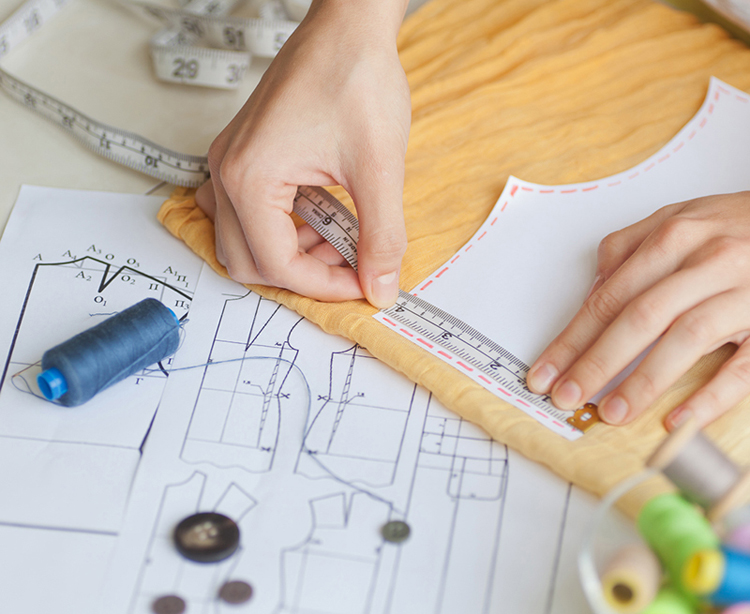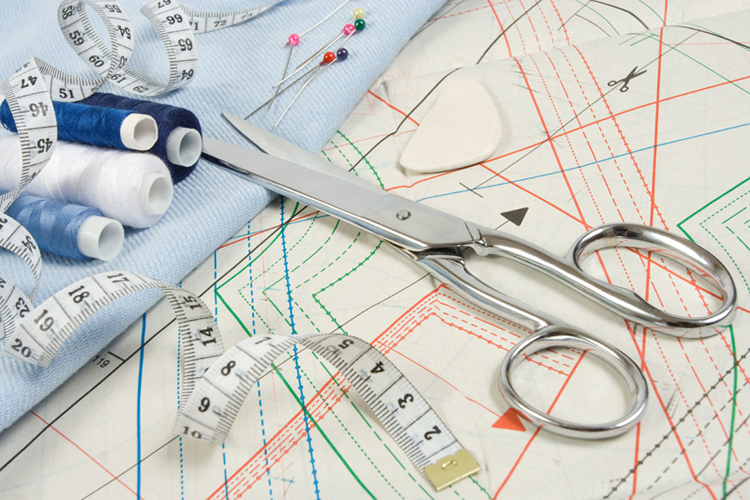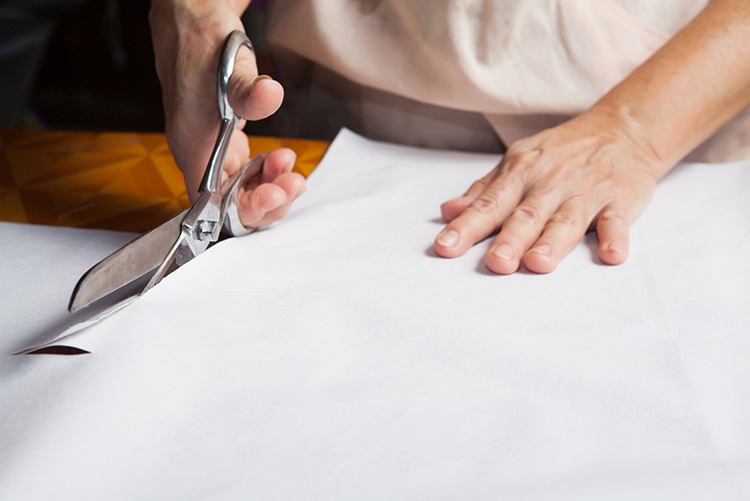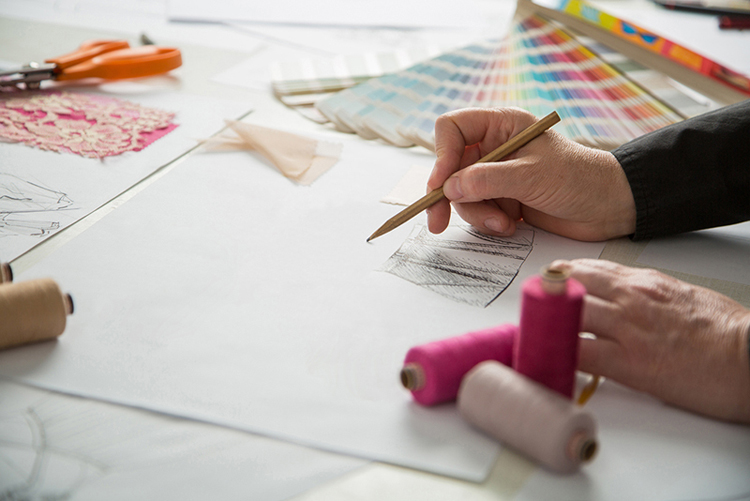In today's article, I would like to tell you what a pattern really is. Let's take a look at ready-made sizes, use of size charts, and why you may not be able to make the garment fit perfectly without pattern adjustments even after careful measurement and selection of the appropriate size.

Sizes, size charts and measurements
Many beginners and even advanced sewers think that clothing pattern is a type of form (such as baking form) to which you put ingredients in, bake it for a while and end up with a perfect cake. Unfortunately, this is not the case, it is simply not possible. When you look around you rarely see people who have exactly the same physical constitution and measurements as you. Meeting someone who has the same chest, waist and hips measurements won’t be such a rare event. But it may be a bit harder to find someone who has the same measurements and the same height. Now imagine that you would like to find someone who is equally tall, has the same measurements and even the same proportions. When I say proportions, I mean shape of hips, buttocks, breast size and shape, distance from chest line to waistline, etc. To put it simply, we could find two ladies that have the same height and measurements, but if we make cast of their bodies, they still would not be the same. So, what is the probability that your body corresponds to some average size? Very, very, small!
So, what exactly do the pattern sizes and shapes and sizes of mannequins come from when they fit almost nobody? From average. But from what average? From many averages of all sorts of body dimensions. If you like mathematics and statistics, you probably know about the Gaussian curve (bell curve), which represents continuous probability distribution of a normal distribution. Take, for example, the size of the cups (which corresponds to the difference between the over the bust measurement and under the bust measurement). We would take a large sample of the female population to find out what is the most common cup size. The results would produce the Gaussian curve. There is 1″ (inch = about 2.5 cm) difference between standard cup sizes. “A” cups correspond to the 2,5 cm difference between the over the bust measurement and the under the bust measurement. “B” to the 5 cm difference, “C” to the 7.5 cm difference, and so on. So, let’s put the cup sizes on axis x and see the bell curve. Normal distribution is characterized by two variables: mean μ (5 in our case) and standard deviation σ (1,25 in our case – half of 2,5 which is the “range” of each cup size). The size B cup is therefore characterized by the difference between the over the bust measurement and under the bust measurement in the range of 3.75 - 6.25 cm. Which is quite a lot of variance for one cup size.

This is then used in pattern design and development - you work with the midpoint of each cup size range (2.5 cm for A cups, 5 cm for B cups, etc.). But in reality, there aren’t many ladies with the exactly 5 cm difference between over/under bust measurements (only about 10% of the total sample in our case).

What does this mean for us?
According to our Gaussian curve, about 70% of women could wear B cups. That's why most patterns and ready-made garments are made for B cups. But in reality, this size is perfect fit for only 10% of the female population. In other words, if 70% of women wear B cups, because that size fits them “best”, it’s the perfect fit for only 10% of them!
What can we do about it?
Imagine that my basic size chart with sizes 32 - 62 contains a total of 16 sizes (yes, I actually make some patterns in up to 16 sizes). These sizes reflect three basic measurements - chest circumference, waist circumference and hip circumference. Measurements of given size are 4 cm smaller/larger than measurements of neighboring sizes (for example, chest circumferences are: 76 cm – 80 cm – 84 cm…).

Now imagine that I would also consider body height, because it also plays a big role. I would have to create absolutely staggering amount of size charts and pattern versions for all possible measurement combinations. Clothing patterns are usually designed for an average height - 168 cm for ladies. This value again corresponds to the mean value (the peak) of our Gaussian curve. In other words, the average female height is 168 cm, but women who actually measure exactly 168 cm are a minority.
So, imagine that I’ve also created 5 size groups for body height. There would be 5 “height variations” for each size, that’s 80 pattern sizes in total. And that’s not the end of it. Imagine three women who are exactly 168 cm tall. So lucky! It’s almost as if I were designing patterns just for them, but ... It turns out that the first one has very long legs and a shorter torso, the other has shorter legs and a long torso and the third is somewhat in between. So, suppose I would add three more “proportional variations” (different sleeve lengths, waistline positions, etc.) to each of those 80 size/height variations. That would be a total of 240 different pattern sizes! On top of that imagine adding the aforementioned cup sizes, for simplicity, let's say we only have 5. So, we'll multiply our 240 sizes by 5 - because women with different chest circumferences, different heights and so on can also have different cup sizes - that’s 1,200 pattern variations! And this is how I could continue because, for example, the hips circumference says nothing about whether a woman has a wide pelvis and a flat buttock, or a narrow pelvis and a rounded butt. Waist circumference alone says nothing about her overall figure. She can be generally wider and have rather boyish figure or a slim figure with a narrow waist and a bigger tummy, because she is pregnant at the moment, for example. You probably know that the T-shirts for pregnant women look different than a larger men's T-shirts, although the measurements may be the same in both cases…
Quite often the customers write to me “I'm 175 cm tall, I have A sized cups and I can't get a pattern that fits me. What do designers and manufacturers think? After all, there are so many of us like this!” Should designers really think of all possible variations? Would the customers be willing to buy and use a pattern with over one thousand size variations? Would it be even possible to make sense of so many pattern files and sewing/cutting lines in them? How many amateur sewers are actually able take body measurements correctly, regularly, and compare them to each size chart of each pattern every time? (Because designers tend to have their own size charts…) Would the customers be willing to pay for such an extremely detailed fashion pattern? According to my back-of-the-envelope calculation, designing such a cut could easily take a year.
My answer to the question “What can we do about it?” is "Nothing!”
Size charts are very simplified and do not correspond to real female (and children's or men's) bodies, because nobody would want to use exact size charts anyway. It’s just not practical.
So, if someone wants a garment to fit them perfectly, they will have to learn to design patterns themselves, or they will have to find a highly skilled tailor. Unfortunately, most tailors work with ready-made patterns, so even that is not a guarantee.

Sizes of clothing in stores vs. Sizes from size charts
The sizes of the clothes from stores are very different from the sizes used to design the patterns. It would be quite nice if there were 16 different sizes of each article in stores. It would be really easy to choose the right size, wouldn't it? Most retailers use simplified size scale such as “XS - XXXL” (that’s a total of 8 sizes in theory, but in the real world, only four or five sizes are usually available - from S to XL or XXL). You can also see numerical sizes (mostly for women's clothing) starting at 36 and ending at 48. Manufacturers will usually try to “cover” entire population in just seven sizes. You can probably guess how it works in real world - women who would wear sizes 32-38 (12 cm circumferential body dimensions range) according to the size scale for pattern design purposes will choose size S in the store.
Meaning of clothing sizes in stores
Clothing sizes in stores have nothing to do with the sizes of the patterns. Really. I get “I bought a pattern from you, I should choose size 42 according to the size chart, but I usually buy size 36” quite often. A suitable pattern size is usually one to four sizes larger than a size you buy in a store. Because size charts for design purposes are much more detailed and accurate, they must also contain more variations. There are only a few clothing sizes in the stores, so “many” women can wear size M, but they are then scattered in several different sizes according to the pattern size chart.

We can look at it in another way. The clothing industry is trying to dress as many consumers as possible using the smallest number of sizes. This can only be solved by increasing the interval between the sizes (range of each size). For example, the difference between chest circumferences of sizes S and M is usually 12 cm. In other words, women with a chest circumference of 80-92 cm reach for size S, while women with a chest circumference of 92-104 cm reach for size M. This leads to a situation where retail chain dresses a huge number of women (chest circumf. 80 cm to 104 cm) using only two clothing sizes. But we would spread all these women along the eight different sizes using the classic size charts of the pattern! If the manufacturer were to create so many templates for cutting the fabric for so many sizes, he would end up with four times the costs of technological preparation before sewing process even started. And that’s something manufacturers really don't want to happen. On the contrary, every manufacturer tries to minimize costs.
What would I want you to take away from all this? I would like you to know that the sizes you are accustomed to in buying in stores have nothing to do with the size charts that are used for pattern design. So please forget about classic sizes completely when using the size charts to choose the right size of your pattern. You can’t compare those things, they’re apples and oranges....
I'll repeat it here in another words. I usually offer women's patterns in 16 sizes: 32-62. Do you know about any store where you can find one T-shirt in 16 different sizes so you can choose the one that fits you best? So, I guess now you already see the huge advantage of sewing your own clothes, right?
What’s a clothing pattern
Now we move from sizes and size charts to patterns. So, what’s a clothing pattern and what’s it good for, when we know in advance that it’s not a guarantee of perfectly fitting clothes? As I wrote at the beginning, patterns aren’t baking forms. Clothing pattern is not a finished design for your particular product. As I explained in the previous paragraphs, it is not that simple with sizes. The size charts are simplifications and therefore the patterns, which are based on those size charts, are simplifications too. Clothing patterns are tools with which you need to learn to work. You need to know how to choose the right size, even though you are in a range of several sizes according to the size chart. (You can learn how to choose the right size and make basic adjustments in this video: How to adjust a pattern) Furthermore, it is necessary to know why a clothing pattern looks as it looks and how to adjust the its length and width. You also need to know all the symbols used in the pattern and how to use them if you want to sew good clothes. Think of the pattern as a hammer. When you have to hammer a nail, you need to know how to use the hammer so that you do not bend the nail, otherwise deform it and how not to get hurt. You need to know where to use a nail and where it would be better to use a screw. You should also know that there are many different nails and hammers and a variety of wooden and boards to which you can hammer the nail. Pattern is a powerful tool with which you can use to create great things, but the assumption is that you know how to work with it, what particular one to choose, how to adjust it and so on.
If you think that sewing is only about cutting the fabric and somehow stitching it together, then your idea is unfortunately quite naive. Sewing is a complex skill and not everyone can handle in its entirety. Somebody may be a great pattern designer, but not very good with sewing. Someone else has incredible tailoring skills, but just cannot construct patterns. Others may have great ideas for clothing, but they aren’t able to understand the design process or sewing. Please try to look at sewing in a broader sense. In order to sew a perfectly fitting piece, you have to know how to adjust the pattern and how to work with it (positioning the pattern pieces, transferring the pieces to the fabric correctly, etc.). You also need to know how to sew (that entails ironing, stitching and many other skills), and last but not least, you should also have a sense of overall visual impression.

Sense of overall visual impression
Sense of overall visual impression or "having an eye for it” is very important aspect of sewing. You should be able to objectively and critically evaluate various things so you can make the right creative decisions. Evaluate, for example, whether the given pattern will fit your figure, whether the color combination is the right one for your and this particular piece, whether the chosen material is suitable for your pattern, and so on. Unfortunately, not everyone has this sense. But that’s just how it is, some people have a great musical talent, some don’t. Some can “see it”, some can't. And precisely because we are so different, not only in terms of the size and body type, but also in terms of overall appearance (let’s leave the character aside here), we have incredible power in our hands. We can leave bland clothes from retail chains behind!
You should also know whether you are able to sew your chosen piece at all. When choosing the pattern, fabric and colors, keep in mind all your physical deficiencies and strengths and use them in your advantage. If you have a smaller bust, you probably won’t reach for the top with extra deep cleavage (few can wear those right anyway). You can also take advantage of little tricks and use subtle optical illusions if you choose right pattern for your figure. Well-known example of improper cut selections is when a woman with short legs chooses pants or a skirt with a lower waistline - visually shortening her legs even further. You could find many more of similar “fails”. Often, they happen only because of ignorance - ignorance of the fact that clothing can cover minor shortcomings and highlight advantages.
Conclusion?
Although it may seem that sewing is too complicated, it’s not that bad.
It's just important to realize a few facts:
- a) Patterns are tools, not exact “baking forms”
- b) Tutorials are just suggestions - make the pattern yours, be creative
- c) Sewing is a craft that is associated with many skills - it is a learning process
- d) Crafts should always be practiced with love and humility
I would like to remind you of the video tutorial that I made for you. So, besides the fact that if you choose the right pattern size you will achieve a much better result than with the clothes you buy, you can also adjust the pattern for the perfect fit. You can learn more about that in this video:
Have a nice day, Peťa




















